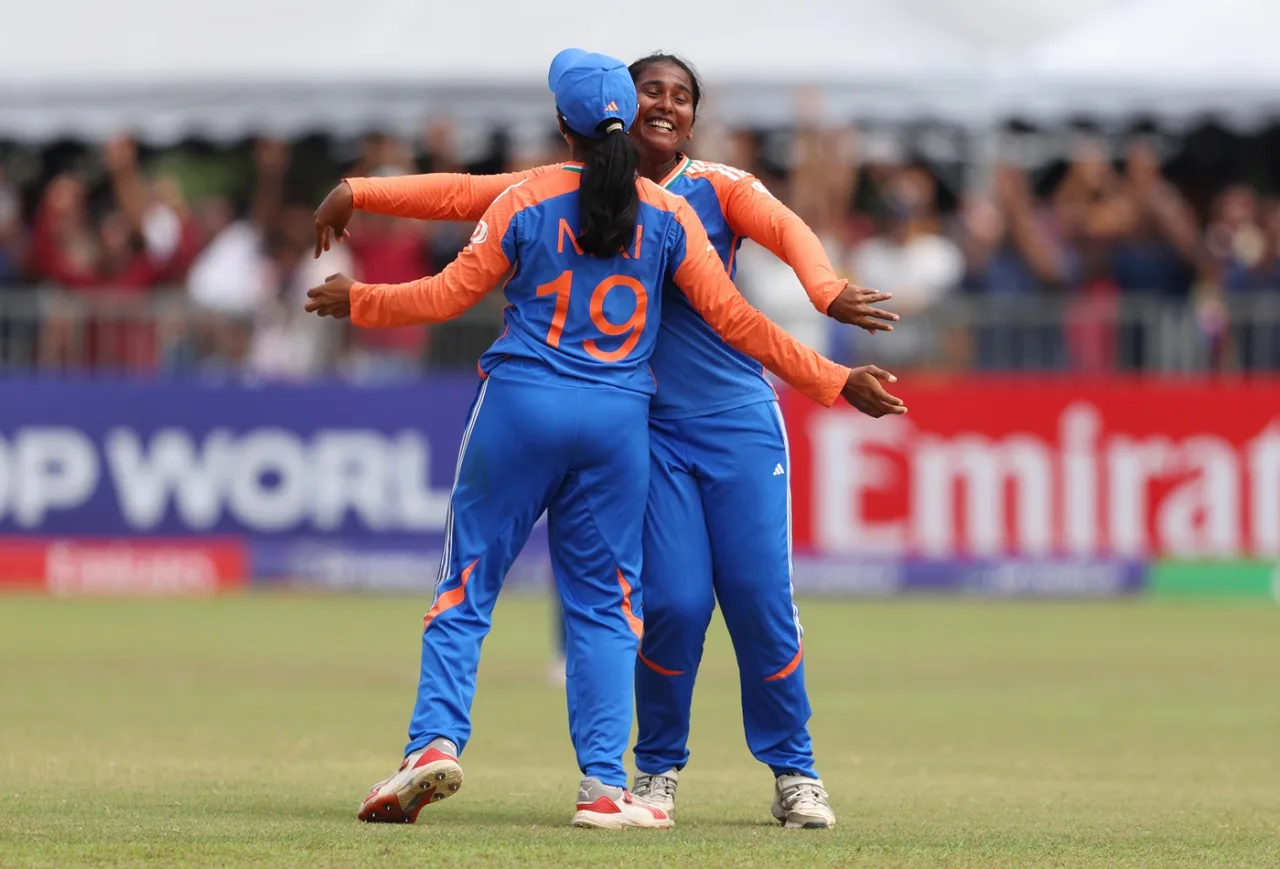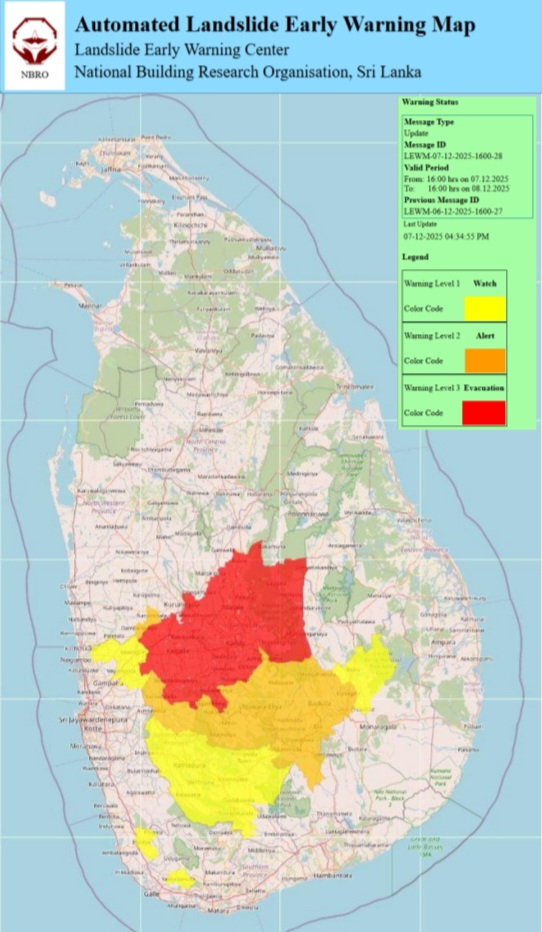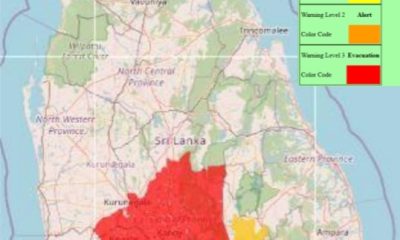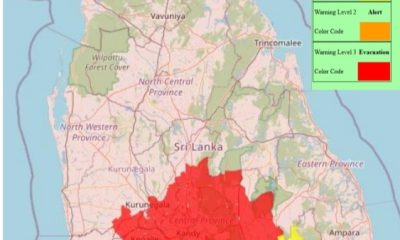Latest News
Trisha excels with bat and ball as India become back-to-back Under-19 champions

India’s spin bowlers continued to be as brilliant as they’ve been throughout the tournament to take them to their second consecutive ICC Under-19 T20 World Cup title.
On the back of the efforts of Aayushi Shukla, Gongadi Trisha, Vaishnavi Sharma and Parunika Sisodia – who took nine wickets between them – India restricted South Africa to 82. Trisha then starred with the bat as well, helping chase down a simple target in 11.1 overs to leave a heartbroken South African side in tears at the Bayuemas Oval in Kuala Lumpur.
Brief scores:
India Women Under 19s 84 for 1 in 11.2 overs (Gongadi Trisha 44*, Sanika Chalke 26*, Kayla Reyneke 1-14) beat South Africa Women Under 19s 82 all out in 20 overs (Karabo Meso 10. Mieke van Voorst 23,Fay Cowling 15; Gongadi Trisha 3-15, Parunika Sisodia 2-06,Aayushi Shukla 2-09, Shabnam Shakil 1-07) by nine wickets
[Cricinfo]
Latest News
Government prepares Anuradhapura farmers for Maha Season

President Anura Kumara Dissanayake instructed officials to prepare the farmers in the Anuradhapura District whose paddy cultivation was destroyed due to floods to re-cultivate during the upcoming Maha season.
Highlighting the need for all relevant institutions to work in proper coordination, treating this as a national necessity, the President instructed the authorities to provide compensation to farmers without delay and to ensure temporary irrigation water supply through provisional repairs.
The President further noted that the government is providing the highest amount of compensation in the country’s history for crop damages, with the expectation that cultivation activities will be commenced again promptly.
President Anura Kumara Dissanayake gave these instructions this morning (07) while attending a special coordination committee meeting at the Anuradhapura District Secretariat to review the programme being implemented to restore normalcy to the lives of people affected by the disaster situation and to rehabilitate damaged infrastructure in the district.
The President instructed officials to present, before this Friday, a report detailing the number of farmers who were completely affected, the extent of damaged farmland and the required financial allocations. He emphasised that compensation must be granted only to those who are genuinely entitled and that no one should receive it unjustly.
The President stated that the government is committed to providing compensation to the farming community and directed officials to foster confidence among farmers so that they will be encouraged to resume cultivation.
The President also inquired, separately, from the relevant institutions about the measures taken for the development of the district’s infrastructure including highways, irrigation and communication networks.
The President examined the programme for reopening obstructed roads and instructed that temporary repairs be expedited to meet the public’s transportation needs until permanent road development plans are implemented.
Officials of the Ceylon Electricity Board informed the meeting that 473 out of the 580 electricity transformers damaged due to the disaster have already been restored and that full electricity supply to the district could be achieved by tomorrow.
They further stated that 49,000 water connections had been affected, of which about 99% have now been restored, while water is being supplied by bowsers to the remaining areas. They noted that total restoration of water supply is expected within the next two days. Damaged community water projects are also being restored.
Well-cleaning activities are currently being carried out with the support of the Navy and the President instructed officials to complete these tasks swiftly through community participation coordinated by Divisional Secretariats.
Discussions were also held regarding the provision of compensation for crops such as Maize, restarting cultivation, restoring the livelihoods of those engaged in animal husbandry, normalising health services and rehabilitating religious sites including damaged temples.
The floods have caused total damage to 228 houses in the district. The President instructed officials to gather accurate information on whether affected families should be resettled on the same land or relocated elsewhere and to begin identifying suitable land for resettlement.
Officials reported that all schools in the district could reopen by 16 December. The President instructed that the Rs. 15,000 allowance promised by the Treasury for schoolchildren affected by the disaster be fully distributed before 31 December and that the list of beneficiaries be prepared without delay.
The President also expressed his gratitude to government officials, the Police and the Tri-Forces for their service in providing relief to the public and restoring infrastructure.
The meeting was attended by Co-Chair of the Anuradhapura District Development Committee, Minister of Trade, Commerce, Food Security and Cooperative Development Wasantha Samarasinghe, Minister of Housing, Construction and Water Supply Susil Ranasinghe , Anuradhapura District MPs Susantha Kumara Navaratna and Sena Nanayakkara, North Central Province Governor Wasantha Jinadasa, Chief Secretary J.M.R.P. Jayasinghe, representatives of local authorities; Secretary to the Treasury Dr Harshana Suriyapperuma, Anuradhapura District Secretary K.G.R. Wimalasuriya, ministry secretaries and other government officials.
Latest News
Level III landslide warnings issued to the Districts of Kandy, Kegalle, Kurunegala and Matale extended till 1600 hrs on Monday [08]

The Landslide Early Warning Center of the National Building Research Organisation [NBRO] has extended the RED landslide early warnings issued to the Districts of Kandy, Kegalle, Kurunegala and Matale until 1600hrs on Monday [8th December 2025].
Accordingly,
LEVEL III RED warnings have been issued to the Divisional Secretaries Division and surrounding areas of Pathadumbara, Pathahewaheta, Harispattuwa, Doluwa, Thumpane, Poojapitiya, Udunuwara, Gangawata Korale, Akurana, Minipe, Udapalatha, Hatharaliyadda, Kundasale, Panvila, Medadumbara, Ududumbara, Deltota, Pasbage Korale, Yatinuwara and Ganga Ihala Korale in the Kandy district, Bulathkohupitiya, Mawanella, Aranayaka, Galigamuwa, Warakapola, Kegalle, Yatiyanthota, and Rambukkana in the Kegalle district, Rideegama, Alawwa, Mawathagama, Mallawapitiya and Polgahawela in the Kurunegala district, and Rattota, Wilgamuwa, Laggala Pallegama, Ambanganga Korale, Ukuwela, Matale, Naula, Pallepola and Yatawatta in the Matale district.
LEVEL II AMBER warnings issued to the Divisional Secretaries Division and surrounding areas of Uva Paranagama, Badulla, Kandeketiya, Bandarawela, Soranathota, Hali_Ela, Meegahakivula, Ella, Welimada, Haputhale, Lunugala, Haldummulla and Passara in the Badulla district, Dehiowita, Ruwanwella, and Deraniyagala in the Kegalle district, Narammala in the Kurunegala district, Thalawakele, Ambagamuwa Korale, Norwood, Kothmale East, Kothmale West and Nuwara Eliya, Hanguranketha, Nildandahinna, Walapane, amd Mathurata in the Nuwara Eliya district and Godakawela, Kahawaththa and Kolonna in the Ratnapura district have also been extended.
LEVEL I YELLOW warnings have been issued to the Divisional Secretaries Division and surrounding areas of Elpitiya and Yakkalamulla in the Galle district, Mirigama, Divulapitiya and Attanagalla in the Gampaha district, Bibile and Medagama inthe Monaragala district, and Nivithigala, Kaltota, Pelmadulla, Elapatha, Ayagama, Kuruwita, Kalawana, Imbulpe, Eheliyagoda, Kiriella, Balangoda, Openayake and Ratnapura in the Ratnapura district
Latest News
A mechanism that goes beyond the normal state apparatus is needed to restore public life – President

President Anura Kumara Dissanayake emphasised that a unified operational mechanism, which goes beyond the normal state administration, is required to restore public life after a disaster.
The President stated this while participating in the Kandy District Coordinating Committee meeting held at the Kandy District Secretariat on Saturday (06).morning
During the meeting, the President separately reviewed the progress of the programmes underway to restore essential infrastructure in the district, including the roadways, electricity, water and fuel supply, irrigation systems and communication facilities.
The President instructed officials to utilise the allocated provisions for the next 25 days to complete road clearing activities swiftly, until the permanent reconstruction of roads is completed.
The President also instructed that water supply in the district be fully restored within three days. Until then, the water requirements of the public should be met through bowsers and such activities must be carried out as an emergency measure beyond the usual procedure, with technical support from the Tri-Forces.
Further, he instructed that the cleaning of household wells be carried out under the coordination of Divisional Secretariats and that electricity supply in the district be restored by 31 December through temporary repairs, while major reconstruction work will be carried into the second phase.
The President pointed out the need to identify arable lands and give priority to cultivation. He instructed that cultivable paddy fields be identified urgently and supplied with the required irrigation water and highlighted the importance of coordinated action by the Department of Irrigation, Provincial Irrigation Department and the Department of Agrarian Development.
He also instructed officials to expedite the payment of the Rs. 200,000 compensation allocated to identified farmers and fields and to submit a report on the extent of vegetable cultivation affected in the district within two weeks. Accordingly, Rs. 150,000 per hectare will be paid as compensation to the affected vegetable farmers and necessary amendments will be made to provide the same compensation for losses incurred in banana cultivation.
The impact on the livestock sector due to the disaster was also broadly discussed. The President highlighted the need to maintain updated data regarding the number of farms and livestock.
He explained the need to restart damaged livestock farms swiftly, to restore income sources for the farmers and to meet the country’s food needs, including milk, poultry and eggs.
Discussions were also held regarding restoring fuel supply in the district. Due to road blockage, fuel supply has been disrupted in Pussellawa and Meetalawa. The President instructed that, through coordination between the Road Development Authority, the Tri-Forces and the Police, fuel be supplied to these areas by Saturday [06] evening.
The resumption of schools in the Kandy District was also discussed. The President instructed officials to minimise delays in reopening schools to ensure that examinations are held as scheduled.
The President also examined in detail the steps taken to restore the district’s health services, railways and communication facilities.
Discussions were held regarding housing damage and the resettlement of affected people. The roles of the Geological Survey and Mines Bureau and the required staffing needs were considered.
The President stated that state-owned lands in adjacent areas will be identified and presented for resettlement activities and necessary interventions will be made to release such lands through discussions with relevant institutions. He emphasised that the government’s objective is to resettle people safely and continuous assessment must be carried out to ensure that compensation provided for destroyed and partly damaged houses is used properly for reconstruction.
As all compensation payments will be made under the 2025 Budget, the President stressed the need to complete all payments before 31 December, to avoid a burden on the 2026 Budget. He said the dedication of all state officials is essential to successfully implement the programmes initiated to restore public life.
Attention was drawn to the garbage disposal problem in Gampola. As a long-term solution, the President instructed that, until the relevant Mahaweli land is released, land belonging to the Ceylon Electricity Board be temporarily allocated for the purpose.
Attention was also paid to the damage caused to state institutions due to the disaster situation.
While noting that natural disasters such as floods, storms and landslides cannot be prevented, the President emphasised that the loss of lives and property can be minimised. He stated that a proper study of the Central Highlands is needed and a long-term plan must be prepared to restore the eroding ecological system.
He further highlighted the need to enforce the powers of local authorities to prevent similar disasters in the future, stating that no room should be given for illegal constructions hereafter. He also noted that Ceylon Electricity Board should not provide electricity to such unauthorised locations.
The President stated that although some expected it would take a long time for the country to recover after the disaster, the government has already been able to restore public life to normalcy within a very short period. He added that by working together for a little longer, the desired goals can be achieved.
The President expressed special appreciation for the dedication shown by state officials and the Tri-Forces in carrying out these tasks.
Minister of Agriculture, Livestock, Land and Irrigation K.D. Lal Kantha, Deputy Minister of Transport and Highways Prasanna Gunasena, Deputy Minister of Health Hansaka Wijemuni, Members of Parliament Jagath Manuwarana and Thanura Dissanayake, as well as Central Province Governor Professor Sarath Abeykoon, Chief Secretary G.H.M.A. Premasinha, Kandy District Secretary Indika Udawatta and officials representing all line agencies including the Road Development Authority, Ceylon Electricity Board and the Irrigation Department attended the occasion.
-
News5 days ago
Lunuwila tragedy not caused by those videoing Bell 212: SLAF
-

 News4 days ago
News4 days agoLevel III landslide early warning continue to be in force in the districts of Kandy, Kegalle, Kurunegala and Matale
-

 Latest News6 days ago
Latest News6 days agoLevel III landslide early warnings issued to the districts of Badulla, Kandy, Kegalle, Kurunegala, Matale and Nuwara-Eliya
-

 Features6 days ago
Features6 days agoDitwah: An unusual cyclone
-

 Latest News7 days ago
Latest News7 days agoUpdated Payment Instructions for Disaster Relief Contributions
-

 News2 days ago
News2 days agoCPC delegation meets JVP for talks on disaster response
-

 Business2 days ago
Business2 days agoLOLC Finance Factoring powers business growth
-

 News2 days ago
News2 days agoA 6th Year Accolade: The Eternal Opulence of My Fair Lady













